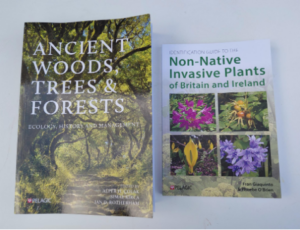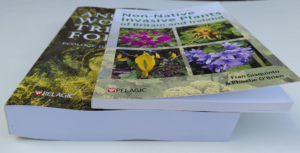TWO book reviews from PELAGIC here:
- Identification Guide to the Non-Native Invasive Plants of Britain and Ireland. By Fran Giaquinto and Phoebe O’Brien. London, Pelagic Publishing. 2025. 154pp. ISBN 978-1-78427-564-8
- A relatively short book but so much is packed into its pages that you do not need more for taking this into the field for indentification. This is a collaborative work from about 50 people, some from the BSBI where following guidelines is important especially with this subject: it is a question of taking this neat fieldguide into the field than picking and bringing material home or to the lab. The second author works a lot in the unique Burren area of Co. Clare, so there is no better grounding for botanising. Both authors are independent scientists and they have done us all a favour of bringing these introduced species into one useful book.
The comprehensive species accounts are arranged loosely under 13 headings which includes trees, shrubs, climbers, grasses, herbs and coastal habitats etc. It works, rather than alphabetically. There is an interesting and refreshing photographic key, list of references, a glossary, a section on resources and an index. The explanations of native, introduced, denizen and archaeophytes are well done. Those species which have legal protection in the UK or EU are indicated.
For newcomers each species is illustrated in colour showing morphological features and one or two ‘lookalike’ species – all very instructive and useful in the field. To me the book is ideal for amateurs and professionals, and as the authors say for gardeners, professional ecologists, environmentalists and all that seek protection of nature and green spaces, free from some of these persistent invasive species.
Ancient Woods, Trees & Forests, ecology, history and management, 2023. By edited by Alper H. Colak, Simay Kirca, and Ian D. Rotherham. ISBN 978-1-78427-264-7 Hbk.450pp. London, Pelagic Publishing
Not many titles from Pelagic are this bulky, long and heavy but for good reason; there are 28 contributors from leading institutions and 22 separate chapters. Two of the editors are from University of Instanbul the other from Sheffield Hallam. The book is as big as some of the tomes of Oliver Rackham and George Peterken, whose presence throughout the book is felt. The book is dedicated to both Rackham and Prof Melvyn Jones.
The contributions from the individuals are precious and invaluable in their way, for instance the chapter from go-to invert expert of old timbers Keith Alexander reminds us that 1,792 species of native wood-decay invertebrate species are in Britain woods, and in Ireland 615 species. There is much evidence of declining insect species, especially beetles, and Anthropocene is often mentioned for the cause.
Throughout the book there are plenty of colour photograph that recreate pleasant field trips to some of the best wooded area around the world of superlative trees and woods, just what the book title delivers. Ted Green is here, author of two Collins New Naturalist Series books, on open-grown trees, Keith Kirby, retired from NE (via EN and NCC) who always pushes conservation boundaries. All can be relied upon for great contributions. This is just a snapshot about authors. The book is probably the best place for a good read on ancient woodlands and wood pastures. Perhaps what British readers might not have got up go speed on are the in depth ancient woodland studies carried out in Germany from old maps, à la Rackham, the analysis of woods in Denmark, Austria and Turkey. One point that has stayed with me is that evidence of the Roman occupation of the land can today be read in the trees and landscape over which we eagerly strive to find answers. After 2,000 years the tree deliver a message.
This is a multi-authored big book, which is a must on the shelves of all who love trees, for all university libraries, all arboriculturalists and for all who are for ever trying to read the environment from its trees, in the updated footsteps of Rackham and Peterkin. As expected each author supplies references at the end of each chapter; and there is a Index.
It is bigger (and heavier, and a little longer) than Rackham’s (1986) The History of the British Countryside, and needs to sit beside it for its wider and more up to date perspective from around the world.

